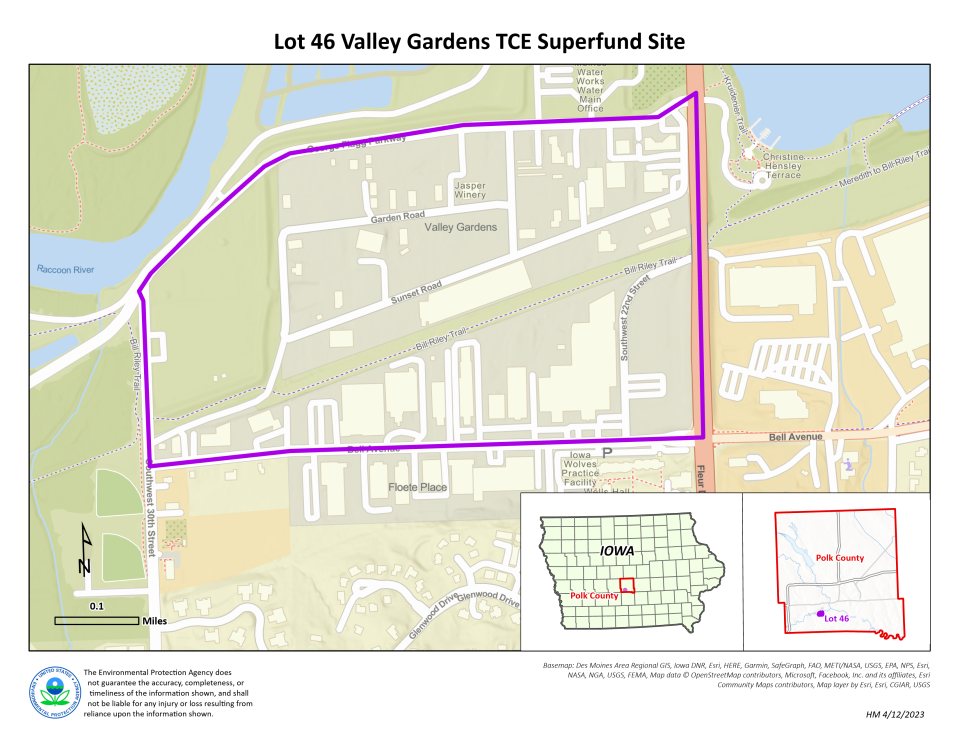EPA adds Des Moines site to Superfund priorities list to protect region's water supply
The U.S. Environmental Protection Agency has placed a contaminated site near downtown Des Moines on the the national Superfund priories list, saying a plume of chemicals in the groundwater there threatens central Iowa's water supply.
The EPA said Tuesday that the groundwater under the site called Lot 46 Valley Gardens, one of five U.S. locations moved to the Superfund National Priorities List, is contaminated with trichloroethylene, or TCE, and two other contaminants that are created when the chemical breaks down.
TCE and a breakdown product, cis-1,2-DCE, have been detected in water samples collected from the Des Moines Water Works intake gallery along the Raccoon River. So far, only the breakdown product has been detected in the utility’s finished water. And those detections were far below what’s considered safe levels for drking water, the EPA said.

The utility, which provides water for 600,000 central Iowa residents, relies on the Raccoon and Des Moines rivers to supply its drinking water supply.
Here’s what you need to know.
Where’s the contamination?
The site is adjacent to Water Works Park, south of George Flagg Parkway and west of Fleur Drive. A half-mile plume is migrating toward the water works’ Fleur Drive plant infiltration gallery, a network of underground water-collecting pipes that runs about 3 miles along the Raccoon River.
The gallery is “a very good source" of water, which seeps through a 30- to 40-foot layer of sand and gravel, helping filter silt, algae, bacteria and other unwanted materials, Ted Corrigan, the Des Moines Water Works CEO, told the Des Moines Register in June.
How did TCE get there?
One or more companies located in Lot 46 Valley Gardens, an industrial and commercial zone, used TCE, contaminating the area with the solvent. The Iowa Department of Natural Resources began investigating the site in 2004 and the state referred it to the federal agency for assistance in 2020, the EPA said.
More: Wells dry and utility service denied, some Des Moines residents rely on trucked-in water
By 2020, the DNR had installed 200 temporary and 24 permanent monitoring wells to monitor groundwater on the site, the EPA said. The federal government has been assessing the contamination. It held public meetings in June and September in Des Moines and has received nearly 200 comments.
TCE has been tied to a host of health problems, including heart, liver and kidney damage.
Is there TCE in my drinking water?
No TCE had been discovered in the finished water the water works pipes to customers, it and the EPA say. And neither TCE nor its degradation products have been detected in the infiltration gallery at concentrations exceeding safe drinking water standards, the water works says online.
Is Des Moines’ water safe to drink?
The Des Moines Water Works meets federal safe drinking water standards, the EPA said Tuesday.
What are officials saying?
The EPA placed Lot 46 on the Superfund National Priorities List to “ensure that the groundwater contamination is cleaned up to protect Des Moines’ water supply and the health of everyone who drinks from the tap in the city,” EPA Region 7 Administrator Meghan McCollister said in a statement Tuesday.
In June, Corrigan said being placed on the Superfund National Priorities List would give the EPA “a big hammer to come in here and get things cleaned up. We’re glad they’re here.”
What’s next?
No immediate timetable is available. The EPA will continue sampling and monitoring the plume while it investigates the best way to remediate the contamination, according to Lauren Murphy, an EPA Region 7 remedial project manager. But the agency can take immediate action if monitoring dictates it, she said.
What kind of funding is available?
The Bipartisan Infrastructure Law is accelerating the EPA’s work to clean up priority list sites with a $3.5 billion investment in the Superfund remedial program, the federal agency said. Because of the infusion, EPA says it's able to clear the pre-existing backlog of unfunded Superfund sites, investing as much in cleanup funding in the past two years as it did in the previous five.
What other projects were placed on the Superfund National Priorities List?
The former Exide Technologies plant in Laureldale, Pennsylvania; Acme Steel Coke Plant in Chicago; Exide in Baton Rouge, Lousiana; and the Lukachukai Mountains Mining District in Cove, Navajo Nation, in Arizona.
Donnelle Eller covers agriculture, the environment and energy for the Register. Reach her at deller@registermedia.com or 515-284-8457.
This article originally appeared on Des Moines Register: EPA makes Des Moines Superfund site priority to protect water supply

